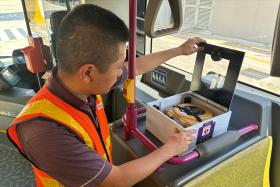Making MRT more reliable taking financial toll on operators: Minister
The reliability of Singapore's MRT network has increased by more than three times since 2017, but this has taken a toll on the train operators, Minister for Transport Khaw Boon Wan said in Parliament yesterday.
This was the result of rail operators SMRT Trains and SBS Transit intensifying their operating and maintenance regime.
That has caused SMRT and SBS' Downtown Line to chalk up operating costs higher than their fare income in their respective financial years ending March 2018 and December 2017.
Mr Khaw, referring to the Downtown Line's latest financial results unveiled on Tuesday, said: "We are combing through the results, and I believe Downtown Line continues to be in a pretty bad shape."
He was replying to Nominated MP Walter Theseira, who asked about the amount of government grants and subsidies expected to be used to cover the operating costs of MRT lines.
Dr Theseira also asked Mr Khaw about the Government's plans should operators continue to suffer substantial operating losses.
He pointed out that the fare formula, which is in place until 2022, does not account for the increased maintenance expenditure.
Mr Khaw said the issue will have to be addressed by the Public Transport Council (PTC), which determines fares for public transport.
He added: "What we have learnt in the last three years is reliability is an engineering problem. It can be fixed, but you need money, you need resources, you need time.
"The secondary question is how do you share the money... you are talking about sharing between taxpayers - through government subsidies - and commuters, through some fare adjustments."
Mr Khaw said the Government has invested and subsidised heavily to ensure Singapore's rail network is "reliable, convenient and affordable".
It is spending about $25 billion in the next five years to expand the MRT network, with the building of the Thomson-East Coast Line, Jurong Region Line and the Cross Island Line.
About $4.5 billion will be spent in the next five years to build, replace and upgrade rail operating assets on the network.
"We are, however, mindful that any decision to increase the level of government funding for rail operations has to be weighed against competing needs, such as healthcare and security," said Mr Khaw.
With the increase in reliability comes customer satisfaction. The latest annual PTC Customer Satisfaction Survey showed commuters were more satisfied with public transport last year, with the biggest improvement in the MRT.
The poll showed the overall satisfaction score rising to 7.9 out of 10, up from 7.7 in 2017. It was the fourth consecutive improvement since 2014.
The MRT score rose to 7.9 from 7.5 in 2017.
RECORD HIGH RIDERSHIP
Public transport was also a bigger hit last year, with ridership rising to another record high. A total of 7.54 million people a day took buses or trains, or 3.8 per cent more than in 2017.
It was the 14th consecutive annual increase in public transport ridership, according to figures released by the Land Transport Authority (LTA) yesterday.
LTA said average rail daily ridership - both MRT and LRT - chalked up the highest increase of 5.7 per cent to 3.5 million rides a day.
Bus ridership rose by 2.2 per cent to hit the four million mark for the first time.
Taxi rides continued to slide with competition from private-hire operators. LTA said cab rides fell 17.6 per cent to 647,000 trips a day.
Get The New Paper on your phone with the free TNP app. Download from the Apple App Store or Google Play Store now


